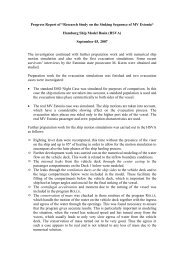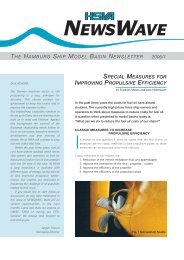You also want an ePaper? Increase the reach of your titles
YUMPU automatically turns print PDFs into web optimized ePapers that Google loves.
6 <strong>NEWSWAVE</strong> 2006/2<br />
RESEARCH PROJECT “SINSEE”<br />
SUCCESSFULLY FINISHED<br />
by Walter L. Kuehnlein<br />
Final results of the German research project “SinSee” were presented<br />
at a colloquium held at <strong>HSVA</strong> on June 22nd. Within the framework of<br />
“SinSee”, <strong>HSVA</strong> cooperated with four partners<br />
(FSG, TUB, TUHH, and OceanWaves) on the<br />
evaluation of safety issues of vessels in severe seas.<br />
Topics like numerical analysis and<br />
simulation, validation by means of<br />
model test investigations, full scale<br />
measurements and evaluation of capsizing<br />
risks were covered within this project.<br />
Available means for investigating the<br />
sea-keeping performance of vessels are<br />
model tests and/or numerical simulations.<br />
Both model tests and numerical motion<br />
simulations are often used post-accidental<br />
in order to investigate the causes. Standard<br />
seakeeping tests (tank or numerical) are<br />
available for investigating several phenomena<br />
such as slamming, green water, capsizing,<br />
etc. but are only occasionally used –<br />
mainly for rather unusual designs, or in<br />
cases where sea keeping characteristics are<br />
more vital than for standard vessels.<br />
Within the research project “SinSee”,<br />
<strong>HSVA</strong> developed the following concept of<br />
computer controlled capsizing tests in<br />
order to ensure that the processes of large<br />
rolling and capsizing take into account the<br />
following wave characteristics:<br />
➢ Extreme wave height and wave steepness,<br />
➢ Wave grouping, and<br />
➢ Propagation velocity and direction.<br />
Unfavourable phase relationships between<br />
wave components as well as wave / structure<br />
interactions may lead to dangerous situations<br />
such as:<br />
➢ Loss of stability at the wave crest,<br />
➢ Resonant excitation, especially<br />
parametric rolling, and<br />
➢ Broaching due to a loss of course<br />
stability.<br />
The analysis of this complex, non-linear<br />
behaviour puts high demands on the<br />
capsizing test set-up and procedure:<br />
➢ Exact correlation of cause (wave<br />
excitation) and reaction (ship motion),<br />
➢ Reproducibility, high accuracy of<br />
measurement and control units,<br />
and<br />
➢ Deterministic performance of test<br />
events.<br />
These demands require a highly sophisticated<br />
testing procedure. Figure 1<br />
shows a schematic test configuration for<br />
computer controlled seakeeping tests.<br />
Three main system components have to<br />
be coordinated:<br />
➢ Wave maker,<br />
➢ Towing carriage (including the transverse<br />
carriage), and<br />
➢ Ship model.<br />
In head seas, the ship is positioned at<br />
the end of the tank opposite to the<br />
wave maker. In seas from astern, the<br />
ship model has to wait close to the wave<br />
maker until a defined sequence of the<br />
wave train has passed.<br />
The ship model is controlled by the<br />
master computer which via telemetry<br />
commands a z-manoeuvre at constant<br />
course angle and model velocity. These<br />
test parameters as well as the model<br />
sea parameters are chosen according to<br />
the metacentric height GM of the<br />
model, the expected rolling mode and<br />
occurrence of resonance. Both the towing<br />
carriage and the transverse horizontal<br />
carriage are computer controlled.





